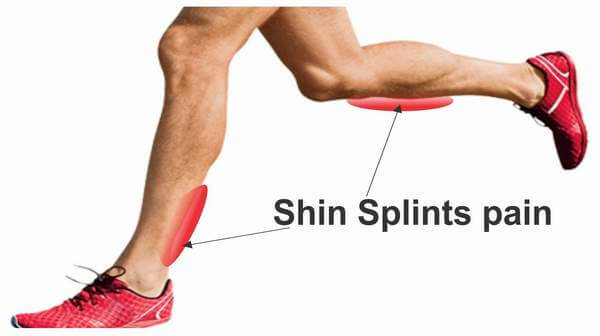In my last blog on SHIN SPLINTS I mentioned briefly another condition, which also relates to overuse and this was PLANTAR FASCIITIS. This is one of the most common causes of heel pain and is when the plantar facia (a thick band of connective tissue that runs from the heel to the toes) becomes inflamed. Usually it takes the form of stabbing pains in the sole of your foot near the heel and can occur when you first get out of bed in the morning, put your foot down on the floor and start walking or when you have been sitting and then go to stand up .It can also arise when you have been standing for long periods of time as well as after exercise.
The plantar fascia is designed to support the arch of your foot and help with shock absorption when you walk, run or jump. During your daily life you can exert a lot of pressure on this area If it becomes too stressed, small tears can occur in the fascia and if this continues repeatedly, then inflammation and pain can arise. Some studies have indicated that it could also be degeneration of the plantar fascia that leads to the problem and this could back up why it tends to occur in slightly older people.
SO WHAT ARE THE RISK FACTORS THAT CAN CONTRIBUTE TO PLANTAR FASCIITIS THAT YOU SHOULD BE AWARE OF?
AGE– Most common in people between 40 and 70, however not exclusively.
EXERCISE / WORK – Anything that places excess pressure on the area such as long distance running or even walking for a long period of time. Aerobic exercise that involves jumping and landing on hard surfaces. Some jobs involve standing for long periods and if you are carrying too much weight or are pregnant, this can cause PLANTAR FASCIITIS too.
INCORRECT OR INAPPROPRIATE FOOTWEAR – especially if you have a very high arch, flat feet or fallen arches. It’s important you have enough support and the correct support in your footwear. You may need to visit a podiatrist (a foot specialist) to advise you accordingly.
OTHER CONDITION– such as SHIN SPLINTS or ACHILLES TENDONITIS where you are forced to change the way you walk in order to reduce the pain in another area such as your calf or ankle, thus placing excess pressure on the sole of the foot. PLANTAR FASCIITIS can then over time lead to other conditions such as back, hip, knee and foot problems.
Usually you would be able to come to the clinic for sports and remedial massage to treat the condition but during this period of lockdown and until you can return to us for more professional treatment, I want to advise you on how you can do certain things at home in order to alleviate the most painful symptoms.
HOW YOU CAN EASE IT YOURSELF.
Alter your mode of exercise for a little while and normally I would suggest swimming but during lockdown, cycling would be a better option. This will take the constant impact away and allow any tears to heal. You can also try inserting a soft insole or heel pad into your shoes. Using an ice pack or bag of frozen peas wrapped in a towel for up to 15 mins every 3 hours on the area and trying to rest your foot, raised slightly on a stool when you get the opportunity. If you are not allergic to them then taking paracetamol can help too. In addition you could undertake some gentle stretching exercises.
SUGGESTED EXERCISES/ STRETCHES
- Sit down and cross one leg over the other knee. Take hold of the base of your toes and pull them back towards your body until you feel a comfortable stretch. Hold for between 15 and 20 seconds and repeat three times.
- Sit down and rest the arch of you foot on a cylindrical/ spherical object such as a bottle of frozen water or a tin of something. You can also use a tennis ball, a Pilates, spikey ball or even one of these hard plastic balls you can use in your tumble dryer to reduce creases in your clothes! Roll the arch in all directions for about five to ten minutes.
- Sit down with a towel on the floor in front of you. Keeping your heel on the floor try to pick up the towel by scrunching it between your toes. Repeat about 15 times.
- Fold a towel lengthwise, which will act as an exercise strap if you do not have one. Sit down and place the towel under the arch of your foot and base of your toes. Gently pull the towel up towards you, bending your toes, which in turn will stretch the plantar facia. Hold for about 30 seconds and repeat three times.
- Stand facing the wall about a foot away. Place the sole of one foot against the wall with your toes pointing upwards and your heel on the ground. You will probably have to bend your other knee slightly to allow you to get into the correct position. Steady your self by placing your hands on the wall. Gently move your pelvis and chest towards the wall until you feel a gentle stretch in your foot and calf. Try to avoid looking down at your feet as this takes away from the stretch. Hold for 15 seconds and repeat three times.
IN ADDITION AND FINALLY
You may have to give running or whatever is causing the issue a rest until the inflammation has a chance to calm down. Everyone is different but as a general rule you might have to stop for a couple of weeks and try all of the suggestions above. You may also need to take something like paracetamol and /or ibuprofen to help ease the pain and inflammation, as long as you are not allergic to them. Then when you feel you can start back again, EASE BACK GENTLY or you could undo all the good work and go right back to square one.
If you find yourself in a situation where nothing seems to be working, even if you have done your best, then you should consult a GP where you may be offered some ultrasound or shockwave therapy, a steroid injection or depending on your situation, surgery. This should be your last resort however and only after you have exhausted everything else.
Simon.






